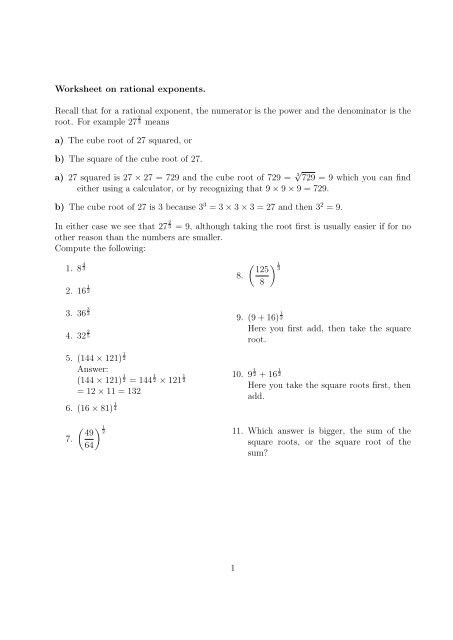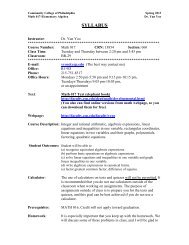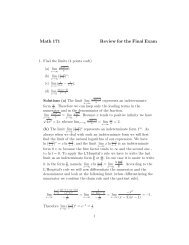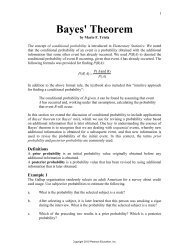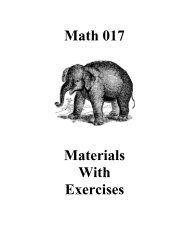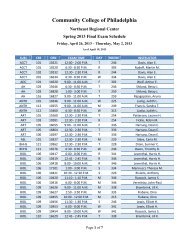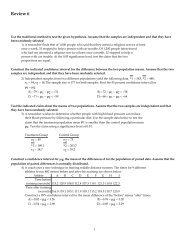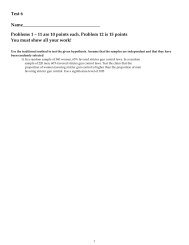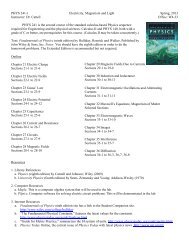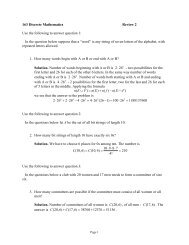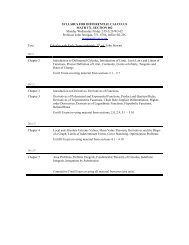Worksheet on rational exponents. Recall that for a rational exponent ...
Worksheet on rational exponents. Recall that for a rational exponent ...
Worksheet on rational exponents. Recall that for a rational exponent ...
You also want an ePaper? Increase the reach of your titles
YUMPU automatically turns print PDFs into web optimized ePapers that Google loves.
<str<strong>on</strong>g>Worksheet</str<strong>on</strong>g> <strong>on</strong> rati<strong>on</strong>al exp<strong>on</strong>ents.<br />
<strong>Recall</strong> <strong>that</strong> <strong>for</strong> a rati<strong>on</strong>al exp<strong>on</strong>ent, the numerator is the power and the denominator is the<br />
root. For example 27 2 3 means<br />
a) The cube root of 27 squared, or<br />
b) The square of the cube root of 27.<br />
a) 27 squared is 27 × 27 = 729 and the cube root of 729 = 3√ 729 = 9 which you can find<br />
either using a calculator, or by recognizing <strong>that</strong> 9 × 9 × 9 = 729.<br />
b) The cube root of 27 is 3 because 3 3 = 3 × 3 × 3 = 27 and then 3 2 = 9.<br />
In either case we see <strong>that</strong> 27 2 3 = 9, although taking the root first is usually easier if <strong>for</strong> no<br />
other reas<strong>on</strong> than the numbers are smaller.<br />
Compute the following:<br />
1. 8 4 3<br />
2. 16 1 2<br />
8.<br />
( 125<br />
8<br />
) 1<br />
3<br />
3. 36 3 2<br />
4. 32 2 5<br />
5. (144 × 121) 1 2<br />
Answer:<br />
(144 × 121) 1 2 = 144 1 2 × 121 1 2<br />
= 12 × 11 = 132<br />
6. (16 × 81) 1 4<br />
9. (9 + 16) 1 2<br />
Here you first add, then take the square<br />
root.<br />
10. 9 1 2 + 16 1 2<br />
Here you take the square roots first, then<br />
add.<br />
7.<br />
( ) 1<br />
49<br />
2<br />
64<br />
11. Which answer is bigger, the sum of the<br />
square roots, or the square root of the<br />
sum<br />
1
To annoy you further, we can also have negative exp<strong>on</strong>ents. This is not such a big deal if<br />
we remember <strong>that</strong> a negative exp<strong>on</strong>ent just means the reciprocal.<br />
( ) −<br />
3<br />
16<br />
2<br />
For example looks bad, but if we tease out the meaning it is comprehensible. The<br />
9<br />
exp<strong>on</strong>ent has three parts:<br />
a) a minus sign,<br />
b) a 2 in the denominator,<br />
c) a 3 in the numerator.<br />
In turn these mean a) the reciprocal, b) the square root, c) the cube (third power). Taking<br />
care of these <strong>on</strong>e at a time we get<br />
a)<br />
b)<br />
c)<br />
( ) −<br />
3 ( ) 3<br />
16<br />
2 9<br />
2<br />
=<br />
9 16<br />
Taking the reciprocal gets rid of the “minus” sign in the exp<strong>on</strong>ent.<br />
( 9<br />
16)3<br />
2<br />
=<br />
( 3<br />
4) 3<br />
Taking the square root gets rid of 2 in the denominator. Finally,<br />
( ) 3 3<br />
= 27<br />
4 64<br />
Not too bad.<br />
Compute:<br />
1.<br />
( 9<br />
4) −<br />
1<br />
2<br />
4.<br />
( 125<br />
8<br />
) −<br />
1<br />
3<br />
2. 32 − 3 2<br />
3.<br />
( ) −<br />
1<br />
49<br />
2<br />
64<br />
5.<br />
( ) −<br />
3<br />
16<br />
4<br />
81<br />
6. 32 − 3 2<br />
2


